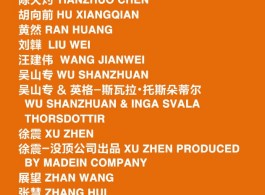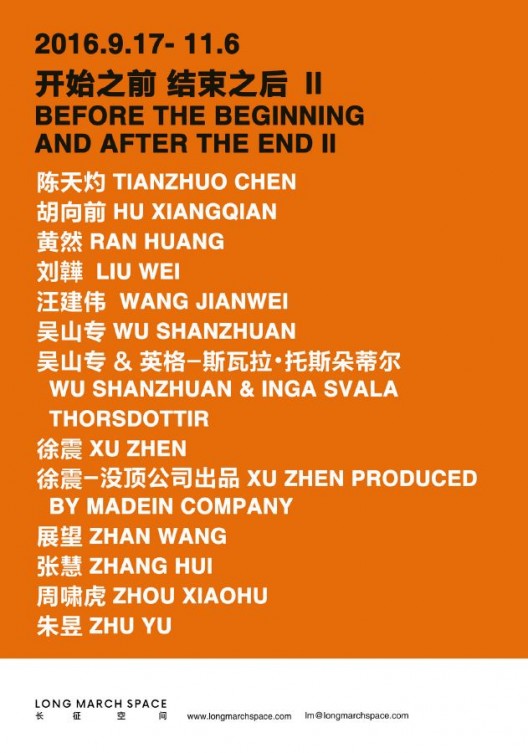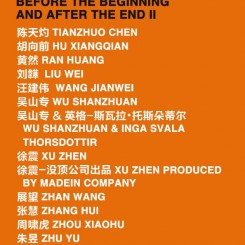Tianzhuo Chen, Hu Xiangqian, Ran Huang, Liu Wei, Wang Jianwei, Wu Shanzhuan, Wu Shanzhuan & Inga Svala Thorsdottir, Xu Zhen, Xu Zhen produced by MadeIn Company, Zhan Wang, Zhang Hui, Zhou Xiaohu, Zhu Yu
The 2014 group show at Long March Space “Before the Beginning and after the End” borrowed inspiration for its title from T.S. Eliot’s classic work Four Quartets, and inspired a different way of looking by researching into the temporal aspects entwined or hidden within the works exhibited. Setting out from this point of inspiration lead to a multitude of results, which ended up in very different understandings of the same work or in fully original comprehensions of the overarching elements of an artist’s creation, even inciting tremors in a state of seeming invariableness. Now in 2016, Long March Space will launch “Before the Beginning and after the End II” exhibiting rarely seen or as yet un-exhibited installations, video pieces and paintings of thirteen artists and artists group. Amongst these are counted works from artists’ early periods or works that marked a turning point in their creative production or a new direction, whereas others are conversely completely new.
As one of the most important artists of China’s ’85 New Wave, Wu Shanzhuan’s artistic practice broke through the established and accepted concepts of visual arts. His painting Little Fat Flesh Perimeter Requiem_2015 May 21 (2015), which gathers together a breadth of grassroots wisdom and the thought processes and incredible spirit of contemporary art, has never before been exhibited.
Wu Shanzhuan & Inga Svala Thorsdottir’s Fielding (2011) has its roots in the symbols of “kuoxuan” and its significance as the “most limited level of openness” in multiplicity and creation, in the unceasing self-perpetuating transformations, and in the repeated and self-propagating patterns in the repetitive back and forth up and down a sloped running track, which is ultimately similar to the white lines on the green turf of a football field.
Zhan Wang’s “Shell of Mao Suit” series of bronze sculptures are amongst the most representative works of his early experimental production which can be seen as a key linkage to the artist’s later “Artificial Rock” series and as an introductory thread towards the artist’s discernment of form and image which would continue to mark a profound influence on his later works.
The new painting by Wang Jianwei comes from his “More” Series (2015-ongoing), which alongside the “Dirty Substance” series reveals a skeptical attitude towards pre-existing objects and a wish to chip away at enforced regulations and standards.
Liu Wei’s immersive comprehensive sculptural installation Panorama (2016) that was shown at the beginning of this year at the PLATEAU Samsung Museum of Art (Seoul, 2016) will also be shown at Long March Space in this exhibition. This work marks a further development from the singular installation work Untitled (2016) in the exhibition space in terms of new materials such as colored acrylic boards and UV printing which add an extra dimension into the works just as the mutual layering between the materials and their reconfigured forms marks off a new way of viewing the pieces, with mutual yet heterogeneous matter caring for each other.
“Xu Zhen”‘s installation Graffiti (2012) displayed a cut cross section of a Santana automobile with a section of a red police light on top, resulting in something which appeared to reveal but an outline on the wall.
Zhu Yu’s Pocket Theology (1999) is the precise work the artist showed as part of the “Post-Sense Sensibility” exhibition which took the lower arm of a corpse and hung it down from the gallery ceiling. Following a similar vein to his early works this installation constructed a query into the nature of humanity and morality.
Zhang Hui’s My Former Lovers Have All Grown Old (2008) conforms to a similar structure as his painted works, in that he used a very basic scene as a substitution to express emotions in linking together different works of the same name or of the same form.
Zhou Xiaohu is considered by many as the pioneering figure in China’s animated art world by borrowing the tools and means of conceptual art to construct environments replete with contradiction. In his etched stainless steel work The Paradox Space (2014), he uses the same methods to transform the inherent understanding towards daily life.
Ran Huang’s paintings in recent years have been inspired by the works of the German artist Martin Kippenberger, whose works he transforms or recreates. The work shown in this exhibition is the newest work of this series and is more the product of a conceptual working process with the entire series being in a constant process of movement, in turn endowing it with aspects more akin to a performance based in the passage of time.
Tianzhuo Chen’s sculptural work Dear is a stage prop from “Tianzhuo Chen: Ishvara” (Long March Space, Beijing, 2016). Half-girl half-skeleton, the form is a sort of religious icon and can be seen as a key piece related to the very “Tianzhuoesque” sculptures of “Divine Forms” present in his recent practice.
Hu Xiangqian’s I will surely sail you into the Pacific Ocean (2005) is the first example of the artist using the means of performance in a documentative video work. It is a proclamation to the self and to the world that the world can be used as the material for art, and he subsequently used the islands on which he lived on at the time as the media to realize this idea. By the end of the video it truly seems as if Hu Xiangqian is rowing and moving the island himself.
Eliot spent his life between “thought” and “poetry” searching not without difficulty for an all-encompassing “universal order”, just as the poem touches upon the thought that “In my beginning is my end… In my end is my beginning.” An artist’s work is precisely thus a cyclical backwards and forwards between beginning and ending in whose constant dedication and self-repudiation lays the pursuit of artistic creation.
The exhibition will continue to be on view until November 6th.



